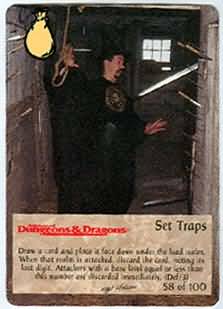Thieves && Assassins Setting Traps-

Thieves && Assassins Setting Traps-

|
|
|
 |
|
|
|
|
|
|
|
|
Simple mechanical traps can
be set by thieves || assassins.
The chance to do so successfully
is equal to that of the chance shown for detecting such traps,
but in
this case the assassin operates at an ability level equal to two levels
above his or her own
and exactly
as if he or she were a thief, e.g. a 5th level assassin has the same chance
of setting a trap as a 7th level thief does.
<the above is not well-worded: i would recommend using the example as the rule. e.g. L1 assassin sets traps as a L3 thief, L2 assassin sets traps as a L4 thief, L3 assassin sets traps as a L5 thief, etc, etc.>
Simple traps are those which
involve mechanical components which the character setting them has normal
access to,
such
as arrow traps, trip wires, and spring-propelled
missiles.
Special devices such as
poisoned needles, scything blades,
and any
similar traps with special mechanical components will also require the
efforts of one or more specialists
-- those required to manufacture
the component parts.
Whenever a thief or assassin
character desires to set a trap,
require
him or her to furnish you a simple drawing to illustrate how the trap will
function.
If the chance to successfully
set the trap results in failure,
there
is a chance of causing injury to the trap setter,
just
as if he or she had set such a trap off.
This
chance is rolled for separately and is the obverse of the chance for successful
setting of a trap.
The drawing
of the trap will modify the chances for injury in cases where failure results.
Modification can be upwards or downwards according to the complexity and
danger of the trap.
Note that even with a prepared
mechanism for a poison needle, for example, the trap must be set, and failure
can result.
Gloves or protective handwear
cannot be worn when setting such traps.
Finally, failure on the first
attempt to set a trap does not mean that the thief or assassin can never
set the trap.
Unlike other similar thief
functions, repeated attempts are permissible.